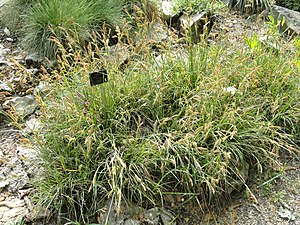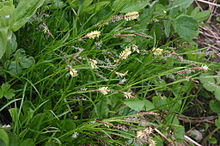Rust sedge
| Rust sedge | ||||||||||||
|---|---|---|---|---|---|---|---|---|---|---|---|---|

Rust sedge ( Carex ferruginea ) |
||||||||||||
| Systematics | ||||||||||||
|
||||||||||||
| Scientific name | ||||||||||||
| Carex ferruginea | ||||||||||||
| Scop. |
The rust-sedge ( Carex ferruginea ) is a species of the genus Seggen ( Carex ) within the sour grass family (Cyperaceae).
description
Vegetative characteristics
The rust-sedge is a perennial , herbaceous plant and reaches heights of 20 to 60 centimeters. Due to the lack of dense foliage at the base, it forms dense clumps . The leaves are runny or creased, over 50 centimeters long, about 1 to 2 mm wide, overhanging rough and slack. In addition to the clumps, extravaginal runners ( breaking through the shoots of the leaf sheaths ) create spaces for other plants. The lowest leaf sheaths are dark purple to purple brown. In contrast to the Horst sedge ( Carex sempervirens ), the leaf sheaths hardly fray when weathered and never form a dense clump of fibers.
Generative characteristics
The flowering period extends from June to August. The rust-sedge is single-sexed ( monoecious ). On an inflorescence there are one to four long-stalked female (0.5 to 2.0 centimeters long) spikelets and one male spikelet.
The number of chromosomes is 2n = 39 or 40.
Occurrence
The distribution area of the rust-sedge extends from the Alps to the western Balkan peninsula and from the southern Carpathians to southwest Bulgaria .
This lime-loving plant species thrives best on fresh to moist (also deep) lime-poor grasslands and rock corridors . In the alpine turf above calcareous rock it forms the stand. It is a character species of the Caricetum ferrugineae from the association Caricion ferrugineae, but it also occurs in contact with plant associations of the associations Poion alpinae, Adenostylion or Erico-Pinion.
In Austria , the rust-sedge is common in all federal states except Vienna and Burgenland and Vienna from the upper montane to alpine altitude . In Switzerland it occurs in the alpine area up to the alpine edge of the Mittelland and in the Jura . In Germany it occurs only in the Alps. In the Allgäu Alps, it rises on the Hochrappenkopf in Bavaria to an altitude of 2400 meters.
literature
- Manfred A. Fischer , Wolfgang Adler, Karl Oswald: Excursion flora for Austria, Liechtenstein and South Tyrol. 2nd, improved and enlarged edition. State of Upper Austria, Biology Center of the Upper Austrian State Museums, Linz 2005, ISBN 3-85474-140-5 .
Individual evidence
- ↑ a b Erich Oberdorfer : Plant-sociological excursion flora for Germany and neighboring areas . With the collaboration of Angelika Schwabe and Theo Müller. 8th, heavily revised and expanded edition. Eugen Ulmer, Stuttgart (Hohenheim) 2001, ISBN 3-8001-3131-5 , pp. 189 .
- ↑ Rafaël Govaerts (ed.): Carex ferruginea. In: World Checklist of Selected Plant Families (WCSP) - The Board of Trustees of the Royal Botanic Gardens, Kew . Retrieved October 18, 2016.
- ↑ Erhard Dörr, Wolfgang Lippert : Flora of the Allgäu and its surroundings. Volume 1, IHW, Eching 2001, ISBN 3-930167-50-6 , p. 274.
Web links
- Rust sedge. In: FloraWeb.de.
- Rust sedge . In: BiolFlor, the database of biological-ecological characteristics of the flora of Germany.
- Profile and distribution map for Bavaria . In: Botanical Information Hub of Bavaria .
- Carex ferruginea Scop. In: Info Flora , the national data and information center for Swiss flora .
- Thomas Meyer: Data sheet with identification key and photos at Flora-de: Flora von Deutschland (old name of the website: Flowers in Swabia ).
- Gerhard Nitter: Profile with photos.


